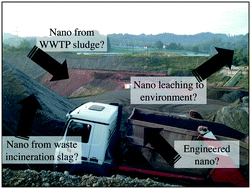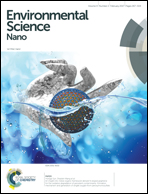Mobility of metallic (nano)particles in leachates from landfills containing waste incineration residues†
Abstract
Incineration of municipal waste and sewage sludge is becoming an increasingly popular option for the disposal of waste materials and energy generation. The incineration process can concentrate metals in the incineration slags deposited in landfills. Emitted leachates contain a myriad of salts and metals; some of them in (nano)particulate form. In this study we collected the leachate from a Swiss landfill for municipal solid waste incineration (MSWI) residues along with the slags deposited at this site (waste incineration bottom ashes and fly ash, sewage sludge incineration bottom ash) from which simulated leachates were prepared. Basic water quality analysis (pH, DOC, TSS, major ions) and natural, incidental or engineered particles suspended in the leachate were characterized by NanoSight (for general size range), serial filtration with ICP-MS analysis for element specific particle size quantification and TEM/EDX to visualize particle morphology and composition. Special priority was given to those elements that have engineered nanoparticulate counterparts (Ti, Zn, Ag, Cu, Fe and Ce) to give an indication of 1) the current concentration and form of these particles emitted from the landfill, 2) the potential presence of engineered nanoparticles already in the samples, and 3) trends in particle size (change) in the leachate from different slags to provide an indication on particle mobility. Zn, Ag, and Cu had appreciable concentrations associated with small particulate matter (nano and 0.1–0.45 μm size fractions) in natural and laboratory prepared leachates, while Ti (nano)particles were most abundant in the landfill leachate. Multiple sampling dates suggested relatively steady particulate matter in the leachate for most elements, but analysis of differently aged bottom ash slags from municipal waste revealed differences with age, indicating the influence of slag weathering in metal mobilization. MSWI residues are inherently a complex mixture of stable and unstable materials that are subject to continuous and dynamic changes over time. Therefore, in this manuscript we placed an emphasis on understanding the geochemical processes that are associated with MSWI residue weathering and how this may dictate the likelihood of particulate metals leaching into groundwater.



 Please wait while we load your content...
Please wait while we load your content...